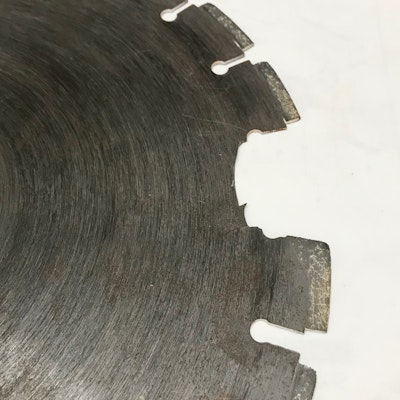Diamond Blade Tips
- Open up the diamonds on a new blade with shallow cuts in soft, abrasive material (eg. limestone). This will stop the blade chattering or skipping on the first job.
- For normal cutting, multiple shallow cuts (step cuts) are better than one single deep cuts.
- Do not force the blade. Forcing or twisting the blade can cause bluntness, excessive wear, overheating, distortion and segment damage.
- Do not side grind.
- If your slurry colour changes to brown or red, you are most probably cutting the dirt or sub base. This will wear your diamond blade quicker, so raise your blade.
- If you're going to change directions on a floor saw, make sure your machine is off and the blade is up out of the cut before changing direction.
- If your blade does not have a direction indication on it, you should be able to see a "comet tail" behind exposed diamonds if the blade was "broken in" at the factory. This indicated the direction - the tail should be behind the comet. If you put a blade on in the direction opposite to the directional arrow you may experience a little slower cutting or a little vibration at first until the diamond is exposed on the opposite side. This should not harm the blade as long as you maintain the same direction but may reduce the life slightly if it is continually reversed.
- A smaller blade on your machine will decrease the cutting depth, but increase the power and speed of cutting. For example, many customers use 12"/300mm blades on a cut off saw that could use a 14"/350mm blade.
- If you are using the blade dry (not recommended due to dust and safety issues), be aware that it will shorten the blade's life, and you will need to air cool the blade regularly - take the blade out of the cut to allow the air to prevent the blade from overheating.
Diamond Blade Troubleshooting
Glazing - This is one of the most common diamond blade problems. As a diamond blade is used, the bond wears, exposing more diamond that continue cutting.
If the bond does not wear down, then eventually there is no diamond exposed, and the blade will slow down and stop cutting. The cutting surface of the blade will feel smooth.
This is known as glazing or polishing.
Rectify by re dressing the blade by cutting an #80 grit dressing stone ( we sell them here ).
As an alternative, use an abrasive material like limestone to remove some bond and expose diamonds so cutting can continue.
Possible causes of glazing are:
- The bond is too hard for the material it is cutting - select the correct blade.
- Too much water is being used (sometimes unavoidable if the tile cracks easily with heat)
- The machine is not powerful enough for the specification (usually experienced more with professional blades and saws)
- The blade has been mounted with the rotation arrow the wrong way.
See this short video on how to deglaze your diamond blade (in this case a tile saw blade, but the basics are the same for all blades).






